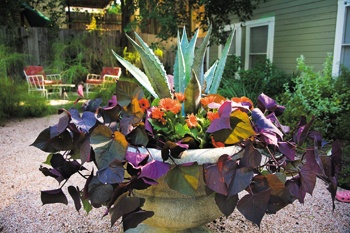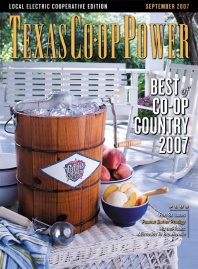I never used to think much about gardening in containers. I lived for many years in the rural Northeast, where it was just as easy to drop plants right in the ground and watch them thrive. Sure, a few houseplants would spend the summer out on the east side of the house, sheltered by a sprawling wisteria under the high canopy of an ancient black walnut tree. But I lived in the country and had plenty of space to garden and good garden soil and compost—but few spare resources to spend on “unnecessary flowerpots.”
Time and experience have changed that. I am aware of far more opportunities in the garden than I would have imagined in my earlier years. Sometimes even simple additions can create complexity and excitement in the garden. Gardening in containers can have a big impact and add a sophisticated, artsy feel to an otherwise average landscape.
The possibilities are vast. Small, well-kept terra-cotta pots can hold a collection of favorite succulents such as sempervivum (hens and chicks) and sedum (stonecrop). Robust glazed Asian containers in rich colors can stand alone as sculptural elements or focal points, act as garden-room dividers, or bring elements of your home’s design out into the garden.
Fill them with exotic looking plants such as cannas, papyrus or brugmansias (angel’s trumpet), and you create an oasis that leaps into view. Most containers are portable enough to easily change the scene to suit an occasion, or divert the focus when part of the garden is past its prime. Plantings can change each year, creating different moods and combinations without landscaping the entire garden again.
So where do you begin? Your yard may have a range of spaces—areas that you gravitate to when you want to relax, sections you enjoy working in most, and forgotten corners that coast through the seasons with little notice. Container gardens can add height and dimension where there was only empty space.
Consider the view from indoors as well. A lushly planted urn or bowl framed in your favorite window can bring the garden indoors and create a feeling of connection with the outside. If you aren’t content with your container garden, changing or relocating plants is easy.
With that in mind, consider your passions next and look at the style of your garden. In your landscape, are you a collector of many small plants, or do you lean toward simple, big and bold? That may be your preference in your containers as well, but before you get started, whichever one describes you, consider doing the opposite in your containers. This is an opportunity to try something new to you.
For most of us, the range of plants has never been easier to explore. Traditional and colorful annuals will blaze in containers all summer and are standard fare for many gardeners, but there are other options. Fast-growing tropicals are often available at quite reasonable prices.
A young majesty palm (Ravena rivularis) may cost no more than a few six-packs of petunias, but it can have several times the impact. Bold, swaying grasses can create motion and energy in a static space. Cannas, colocasia (elephant ear), eucomis (pineapple lily) and other tender summer bulbs grow quickly, and their large leaves can be an exotic contrast to the finer textures of many hardy perennials.
Cacti and succulents have a sculptural quality that is shown to great advantage when raised above garden level, and they thrive in well-drained containers. In much of the United States, many hardy cacti can remain in their containers in the garden all year as living works of art. This lifts their prickly pads and stems up out of surrounding vegetation and makes caring for them much easier.
Hardy conifers can lend stability and texture to a container grouping. Many dwarf types can remain for several seasons for a more permanent effect on a balcony or terrace. Larger sorts may be planted directly into the garden when their increasing size no longer suits the container. Either way, colorful and unique cultivars can be absolute treasures and stand apart all year as living sculptures.
There are few limits to your creativity when planting container gardens. Experiment with leaf shape, movement, color and texture in combinations that you may not have tried before.
Potted gardens can be flexible and colorful additions to a garden that needs that elusive “something extra.” You may find, as I did, that those “unnecessary flowerpots” have become essential elements of a rich and dynamic garden design.
——————–
Dan Johnson has been gardening for as long as he can remember and has worked in the green industry for more than 25 years.


